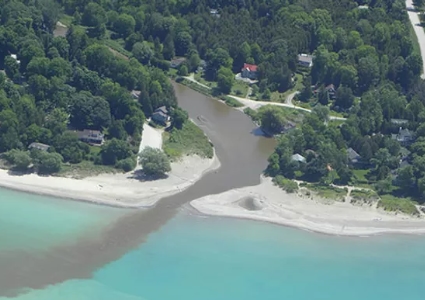Polling

Suggest an important issue not listed in this sub-category (). (Maximum 60 Characters)
Nonpoint source pollution

Nonpoint source pollution (NPS) refers to the presence of untraceable sources of contaminants in a polluted water supply. This pollution is often caused by rainfall or snowmelt moving over and through the ground. This runoff often picks up pollutants as it migrates, depositing it into rivers, lakes, wetlands and coastal waters. Some nonpoint source pollutants include runoff from farm fertilizers and pesticides, waste from animal feedlots and aquafarms, acid mine drainage, and oils and salts from our roadways which are washed into city storm drains.
As the sources of NPS are widely varied, so are its solutions. Urban solutions include the use of porous pavement and buffer strips of grass or dirt barriers placed between paved surfaces and the closest body of water. These measures allow the soil to absorb contaminants from stormwater before it enters a waterway. Retention ponds can also be built in drainage areas to catch stormwater runoff, allowing contaminates to settle out and become trapped in the ponds. Farmers can utilize erosion controls to reduce runoff and retain soil on their fields. Common techniques include contour plowing, crop mulching, crop rotation and planting perennial crops. Farmers can better manage their use of fertilizers to reduce excessive application of these nutrients. They can also employ integrated pest management techniques, including biological pest control, to reduce their use of chemical pesticides.
Proposed Legislation: Reintroduction of S.29 - Local Water Protection Act (117th Congress 2021-2022)
Prospective Sponsor: Sen. Amy Klobuchar (MN)
As the sources of NPS are widely varied, so are its solutions. Urban solutions include the use of porous pavement and buffer strips of grass or dirt barriers placed between paved surfaces and the closest body of water. These measures allow the soil to absorb contaminants from stormwater before it enters a waterway. Retention ponds can also be built in drainage areas to catch stormwater runoff, allowing contaminates to settle out and become trapped in the ponds. Farmers can utilize erosion controls to reduce runoff and retain soil on their fields. Common techniques include contour plowing, crop mulching, crop rotation and planting perennial crops. Farmers can better manage their use of fertilizers to reduce excessive application of these nutrients. They can also employ integrated pest management techniques, including biological pest control, to reduce their use of chemical pesticides.
Proposed Legislation: Reintroduction of S.29 - Local Water Protection Act (117th Congress 2021-2022)
Prospective Sponsor: Sen. Amy Klobuchar (MN)
Poll Opening Date
February 6, 2023
Poll Closing Date
February 12, 2023
Democracy Rules respects the privacy of your information.
See PRIVACY STATEMENT
See PRIVACY STATEMENT